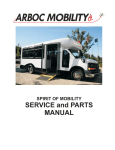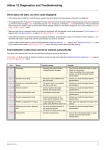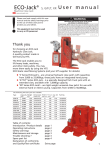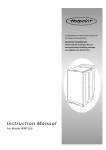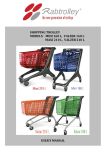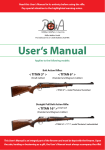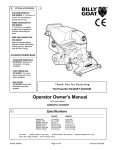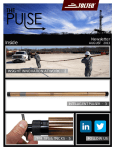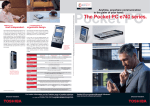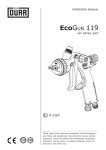Download Technical Manual // Zakk
Transcript
Technical Manual // Zakk Product Versions: V1.1 Revision: 3 www.last-bikes.com Instructions Instructions Please read the entire users quide and technical manual before using the hubs or before carrying out any kind of maintenance work. This manual is intended for retailers with the appropriate skills and knowledge. It details the principle design features of the product and also provides instructions as to maintenance and repair work. Please take special care to use only proper tools in order to undertake the work detailed in this manual. In the event of improper servicing of the hubs, the manufacturer has the right to refuse any warranty. Due to continual improvements that are made to our products, it is possible that the product you have received differs slightly from the models described in this manual. For the newest version of the service manual or for miscellaneous questions, please consult the official representative for the country in which you reside or consult our website www.last-bikes.com. Please give special attention to the following notice which is listed under the title bellow: CAUTION - In the case of non-compliance with these instructions, the function of the product will be impaired, which may lead to injuries with serious consequences, and the loss of the product warranty. Maintenance of the hubs Maintenance of the rear and front hubs must be carried out at least once a year. When used under extreme conditions (heavy rain, mud, transport in the rain etc.) the free-wheel should be serviced more often. Regular maintenance of the hub helps to ensure a longer life and optimum running performance for years. In the case of exposure to water under excessive pressure (e.g. high-pressure cleaners), water may penetrate into the hub. This may damage the hub. Do not use any solvents or detergents. Important • Before every use, check the function of your rear wheel hub. Make sure that the freewheel and engagement connection function impeccably. Should there be any mal-function, the rear wheel hub must not be used. In such a case, the problem must be repaired before use. If you are not in a position to repair the hub, contact a professional bike mechanic. been evenly distributed and the seals have not yet been bedded in. • Radial lacing on our hubs is not recommended as it may lead to impermissible deformations on the hub flange. Flange breakage is not covered under the warranty in this case. • Disregarding these instructions will limit the function of the freewheel and can lead to injury or other severe consequences and the loss of the product warranty. Warranty Terms Please visit our website for the latest version of the warranty terms. • We strongly recommend that you have your wheels built by an experienced specialist. Proper wheel building is the best way to ensure that your wheels will last and be problem-free. • New hubs have a higher rolling resistance than used hubs, because the grease in the freewheel has not yet www.last-bikes.com Installation Installing the wheel/hub For proper operation the wheel must be securely fixed with the bolts to the dropouts of the frame. Therefore tighten the bolts with the given torque using a torque wrench. Max. 35 Nm torque CAUTION - Excessively tightened bolts may cause the hub structure to be damaged. Remark If the wheels is moved by chain forces use a chaintensioner to avoid this. Max. 35 Nm torque www.last-bikes.com Spare Parts 1 Pos. 1 2 3 4 5 6 7.1 7.2 8 9 10 11 12 13.1 13.2 13.3 14 2 3 4 5 6 7.1-7.2 8 9 10 11 5 12 13.1-13.3 4 14 2 1 Description Art. No. Spare part kits Art. No. cup for M10 bolt, black (Zakk V1-V1.1) 000336 driver assembly, 12 T, gold (Zakk V1-V1.1) 000153 bolt DIN 912 M10x30 12.9 (Zakk V1-V1.1) end cap, left, black (Zakk V1.1) locking ring (Zakk V1-V2) bearing 6902.2RS driver/left hub body (Zakk V1-V2), dimensions 28 x 15 x 7 mm axle (Zakk V1.1) hub body with ratchet, 32 hole, bl, (Zakk V1-V1.1) hub body with ratchet, 36 hole, bl, (Zakk V1-V1.1) bearing 6002.2RS, right body (Zakk V1-V2), dimensions 32 x 15 x 9 mm spacer for axle (Zakk V1-V1.1) spring (Zakk V1-V2) pawl (Zakk V1-V1.1) seal for driver (Zakk V1-V1.1) driver only, 11T, gold (Zakk V1-V1.1) driver only, 12T, gold (Zakk V1-V1.1) driver only, 14T, gold (Zakk V1-V1.1) end cap, right, black (Zakk V1-1.1) 000335 000189 000200 000161 000190 000203 driver assembly, 11 T, gold (Zakk V1-V1.1) driver assembly, 14 T, gold (Zakk V1-V1.1) bolts (1) and cups (2), M10, black, (Zakk V1-V1.1) 000151 000154 000166 All driver assemblies include driver, 6 pawls, 2 springs, 2 driver bearings, driver seal and locking ring. 000204 000162 000202 000206 000205 000212 000213 000214 000215 000165 www.last-bikes.com 58 Dimensions www.last-bikes.com Removing the driver Required tools Step 1 Step 2 - 8 mm allen wrench - grip (shown) or 24 mm spanner - vice (not shown) or second grip/24 mm spanner - spacer for disassemly (Art. No. 000337) Remove both bolts and install the spacer for disassembly using one of the bolts on the driver side. Clamp the disc side end cap of the hub using it´s flatened faces with the vice. Tighten the bolt with up to 20 Nm. The grip must have flat parallel faces. If you do not have the spacer for disassembly you may use a tube with 12 mm diameter, 1 mm wall thickness and 10 mm length. Do not use tubes with diameter greater than 12 mm! www.last-bikes.com Removing the driver Step 3 Step 4 Step 5 Use the grip to turn the end cap counter clockwise. Typically the end cap is tightened firmly. When turning the end cap for removal, with the grip, it is important that the reaction moment is split. The reaction moment must be splitted onto the vice and the bolt/allen key. To achieve this, press against the allen key while turning the end cap with the grip. The force on the allen key must be smaller than the force on the grip. The force on the allen key should be about half of the force you use on the grip. Remove the bolt and the tool, while the hub stays clamped in the vice. Remove the drive side end cap. Pull the driver off the axle. www.last-bikes.com Installing the driver Make sure the straight tip (A) of the spring points clockwise when looking on the side of the freewheel which includes the pawls. The orientation of the bent spring tip (B) can differ from the illustration on the right. It is only important that the straight tip (A) is oriented clockwsie as described above and illustrated in the figure. Use light grease on the freewheel mechanism. Push the spacer and afterwards the driver on the axle. When the driver does not move further, rotate the driver counter clockwise against the hub and push gently. This will allow the pawls to set into the ratchet of the hub. Fit the drive side end cap and tighten it with 35 Nm. Use light grease for the freewhell mechanism. CAUTION - The orientation of the spring is important for the performance of the free wheel system. Wrong installation will lead to increased wear and improper function after a certain period of use or instantaneously. A B www.last-bikes.com Removing axle and bearings Required tools Step 1 Step 2 - 8 mm allen wrench - grip (shown) or 24 mm spanner - vice (not shown) or second grip/24 mm spanner - plastic hammer - grip for locking rings - tool set for setting the bearings (Art. No. 000338) - eventually spacer for disassemly (Art. No. 000337) Remove the bolts and cups. Tighten the end cap with 35 Nm. To do so keep the hub clamped in the vice and use the grip. The grip must have flat parallel faces. If you do not have the spacer for disassembly you may use a tube with 12 mm diameter, 1 mm wall thickness and 10 mm length. Do not use tubes with diameter greater than 12 mm! Clamp the driver side end cap with the vice using the end cap´s flat faces. Open the disc side end cap with the grip by turning it counter clockwise. If you are lucky the disc brake side end cap will get loose. In this case remove the end cap completely. Proceed to step 4. If you´re not lucky proceed with step 2. Install the spacer for disassembly using one of the bolts on the disc brake side. Clamp the driver side end cap of the hub using it´s flatened faces with the vice. Tighten the bolt with up to 20 Nm. www.last-bikes.com Removing axle and bearings Step 3 Step 4 Step 5 Use the grip to turn the end cap counter clockwise. Typically the end cap is tightened firmly. When turning the end cap for removal, with the grip, it is important that the reaction moment is split. The reaction moment must be splitted onto the vice and the bolt/allen key. To achieve this, press against the allen key while turning the end cap with the grip. The force on the allen key must be smaller than the force on the grip. The force on the allen key should be about half of the force you use on the grip. The disc brake side end cap should get loose now. If this is not the case, try to push more against the allen key while turning the end cap. Before doing so tighten the end caps again with 35 Nm. In case you have a complete wheel sit down and place the wheel on you legs. If you have a single hub, use the vice. Open it up so the hub flange can be placed on the faces of the vice. Do not clamp the hub. To protect the disc brake flange surface place a cloth or rubber fabric between hub and vice. Use the plastic hammer to push out the axle, driver and bearing towards the drive side. Do not use a metal hammer, otherwise the threaded axle may get harmed. Make sure that axle and bearing have space to be pushed out. Remove the locking ring on the disc brake side using a locking ring grip. www.last-bikes.com Removing axle and bearings Step 6 Step 7 Clamp the axle on it´s flat face using the vice. Open the end cap turning counter clockwise. Remove the end cap completely and slide driver, spacer and bearing off the axle. Place the axle in the hub as it was before. Now proceed similar to step 5 to push out the disc brake side bearing using the hammer on the bolt. Slide the bearing off the axle and remove the bolt. Make sure you have removed the locking ring! www.last-bikes.com Installing axle and bearings Step 1 Step 2 We recommend to use new bearings whenever they have been removed. Removing the bearings can damage the bearings. You may not notice the damage instantly, but the life span will be short. Better replace them now. Use both bearing tools to set the bearings. Close the vice until you feel the bearings bottoming out. Over tightening will harm the axle. Insert the axle and slide on both bearings. Install the remaining parts according to the instructions given in the chapter „ installing the driver“. www.last-bikes.com












